The Essential Guide To Dim Sum For The Chinese New Year
Know exactly how to order thanks to this breakdown of 24 dishes, including photos and Chinese pronunciation.
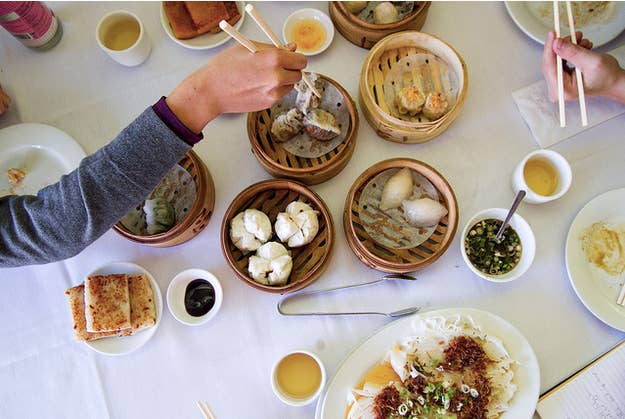
FIRST, A QUICK HISTORY LESSON.
Nowadays, the term "dim sum" (點心 in written Chinese, and pronounced dian xin in Mandarin) is a meal—usually taken on a weekend morning—that encompasses a vast roster of small dishes selected from carts.
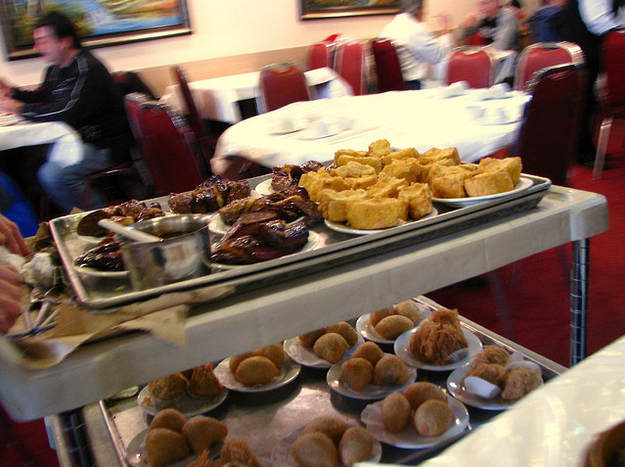
In the beginning, dim sum was a verb that merely meant “to eat a little something.” Cantonese dim sum culture began in tearooms in the latter half of the nineteenth century in the city of Guangzou, possibly because of the recent ban of opium dens. It spread and gained popularity—especially in nearby Hong Kong.
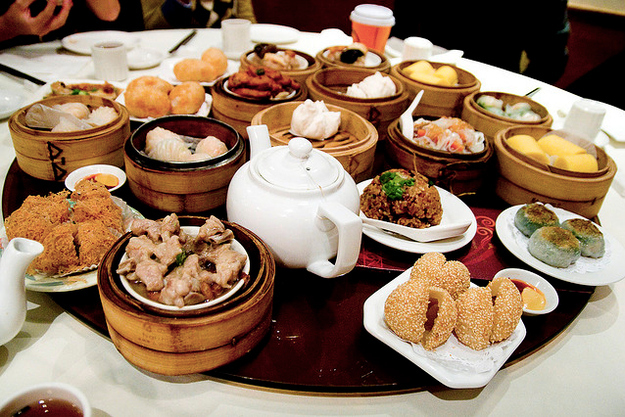
The sort of dim sum restaurant we’re familiar with today in the West originated in Hong Kong in the mid-1950s. These Hong Kong parlors had areas for banquets and even mah-jongg games, and carts pushed by “aunties” (a’sam).

HOW TO USE THE DIM SUM FIELD GUIDE
Regular patrons of North American dim sum restaurants will find most, if not all, of the selections pictured here familiar. Newcomers should find the illustrations—which have been grouped by their method of preparation and general type—helpful in identifying some of the more typical offerings. This arrangement will provide even first-time visitors to dim sum restaurants with access to field identification in a clear and rational array.
The first half of the Field Guide introduces steamed items; the second covers fried, baked, and sweet offerings. These general divisions have then been subdivided according to each dim sum’s predominant physical characteristics.
A common English name for the dim sum is given at the top, along with its pronunciation in both Mandarin and Cantonese Chinese; the characters for these are provided next to the English name, along with alternative standard Chinese names if such exist.
Each entry has its own photo and identifying characteristics are bolded in the text. Below each photo are symbols that offer additional guides to correctly recognizing, categorizing, and appreciating the various varieties of dim sum in this field guide; a key is provided below.
The text also provides aids to recognition through other means of depiction, including size, range, and color. All items originate from Guangdong Province, unless otherwise noted.
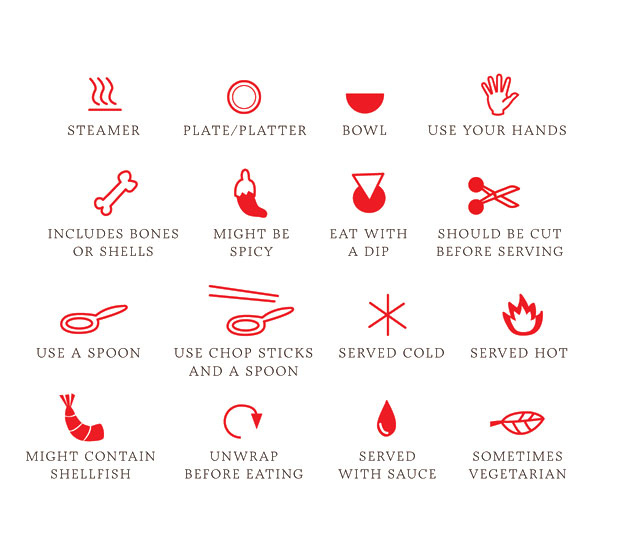

STEAMED DUMPLINGS 蒸餃
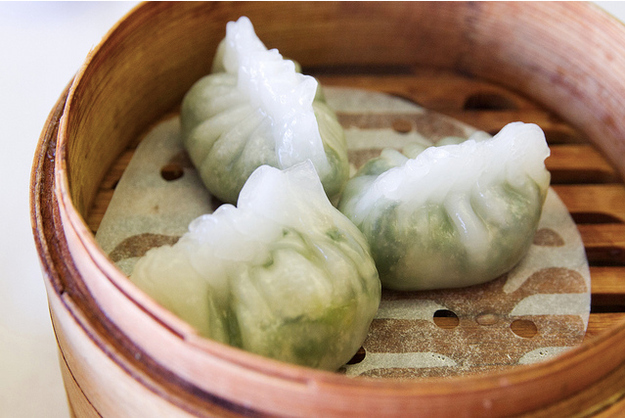

(Mand. zheng jiao; Cant. zing gau)
Unleavened wheat dough wrapper family
The body of these two-inch dumplings have a plump gumdrop shape; their thin skins are closed with simple folds or multiple pleats across the top, The wrappers are made from a light and supple “hot dough,” a combination of boiling water and Chinese noodle flour, and may be colored with vegetable juices like carrot or spinach. Fillings vary, but are usually pork or shrimp with vegetables and aromatics such as ginger, Chinese chives, green onions, bok choy, Chinese cabbage, carrots, black mushrooms, and wood ear fungus. Vegetarian dumplings are typically a combination of vegetables, cellophane noodles and scrambled eggs. Chinese dumplings (both boiled jiao zi and steamed zheng jiao) probably originated in Muslim areas along the northern Silk Road, where wheat pasta was the main staple, but are now common from Beijing in the north to Guangdong in the south. Sometimes steamed dumplings are formed into fanciful shapes, like goldfish and heads of garlic. Exterior tacky; interior juicy.
“SIU MAI” 燒賣
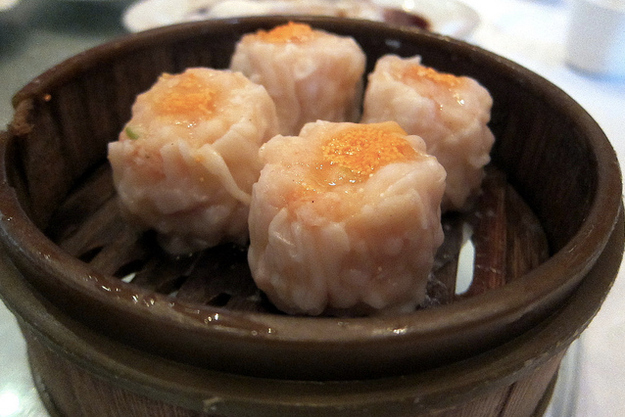

(Mand. shao mai; Cant. siu mai)
UNLEAVENED WHEAT DOUGH WRAPPER FAMILY
Thin, round wrapper in a cup shape holding a filling, usually of pork, shrimp, or a combination of the two, and often a scant amount of vegetables like bamboo shoots, black mushrooms, and water chestnuts. The sides of the dumpling are sometimes gently or noticeably squeezed in to form a flower shape. A garnish of contrasting color—such as Chinese ham, cooked or salted egg yolks, whole peas, or chopped shrimp—is usually sprinkled in the center of the filling. One inch. From Guangdong Province, though these were enjoyed as long ago as the Yuan Dynasty (1271 to 1368) in northern China. (In the northern provinces, siu mai are usually larger, with thick wrappers, and the fillings are almost always pork seasoned with such ingredients as black mushrooms, bamboo shoots, dried shrimp, and green onions.) Alt. spelling: shu mai. Exterior tacky; interior moist but not juicy.
CHICKEN BUNS 雞包仔


(Mand. jibaozi; Cant. gai bao jai)
LEAVENED WHEAT DOUGH WRAPPER FAMILY
Cantonese dim sum bread dough, twisted at the top, filled with chicken and Cantonese sausage. (May contain pork and/or shrimp instead of sausage, and items such as black mushrooms and green onions, along with seasonings and binding ingredients.) Usually has a waxed-paper square on the bottom. Member of the larger-sized bao family that originated in North China, typified by thick, bready wrappers and hefty fillings. Usually has a waxed-paper square on the bottom. Cantonese bao were first sold as snacks in Guangzhou teahouses before they began to appear in Hong Kong and beyond. A legend says that bao were invented 1,800 years ago by the great strategist Zhuge Liang of the Three Kingdoms. He and his troops came across a roiling river, which would remain uncrossable until the evil water spirit had been appeased with forty-nine human heads. Unwilling to sacrifice his soldiers, Zhuge had his men make a meat stuffing and cover it with dough. This was then formed into the shapes of heads, steamed, and offered to the river spirit. The bao met the spirit’s approval, the waters were calmed, and the men crossed without further problem. Exterior shiny white with spongy edges; interior juicy and tender.
STEAMED PORK BUNS 叉燒包
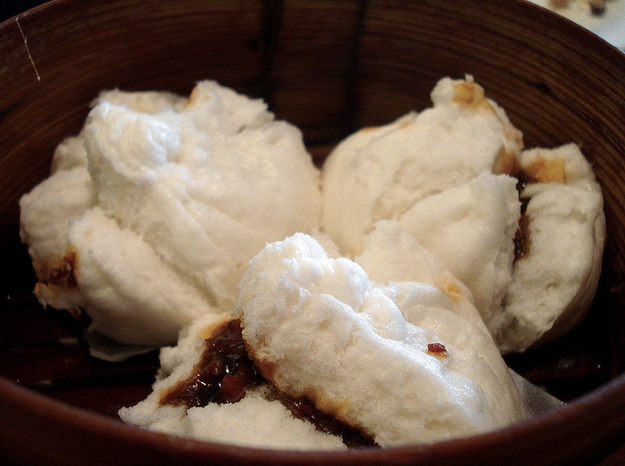

(Mand. cha shao bao; Cant. char siu bao)
LEAVENED WHEAT DOUGH WRAPPER FAMILY
Springy, with a yeasty aroma, this bao is wrapped such that the dough splays open, or blooms into three or so “petals” that are craggy along the edges. The mahogany to scarlet filling—consisting mainly of Cantonese barbecued pork seasoned with soy sauce, shallots, oyster sauce, and sesame oil—is visible between the petals in the finished bao. Usually has a waxed-paper square on the bottom. May also be baked with the folds on the bottom and smooth surface on top so that it does not crack open. In Hong Kong, char siu bao suffers a reputation like that of hot dogs in the U.S.—it’s thought that any mystery meat could end up inside, even human. This urban legend was memorialized in a bloody 1993 Hong Kong movie called The Eight Immortals Restaurant: The Untold Story. Exterior shiny white with spongy edges; interior sweet, savory, flavorful, and chunky with a light gravy.
RICE NOODLE ROLLS 腸粉
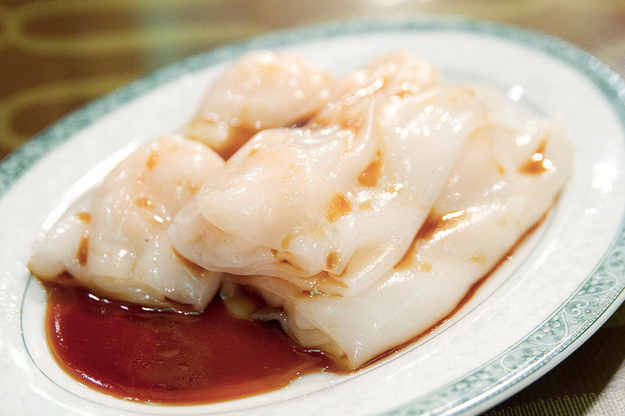

(Mand. changfen; Cant. cheong fun)
MISCELLANEOUS WRAPPER FAMILY
Large, thin, usually handmade steamed rice noodle rolled around a tender shrimp or meat center or a crispy nonmeat filling made out of some sort of fried dough, like youtiao (long, unsweetened Chinese cruller). A primarily shrimp filling is often indicated by large whole shrimp visible on top. Cilantro or sesame seeds may decorate the top of some varieties. Sweet soy sauce or a savory sauce is poured over the dish just before it is cut and served. The name literally means “intestine [rice] noodles” because when these glistening, ever-so-slightly-lumpy sheets are rolled up, they look somewhat like their namesakes. The variety with a fried cruller in the center is usually referred to by another name, zhaliang 炸兩 (Cant. zaa loeng). Exterior glossy, slick, and silky; interior either a juicy meat and shrimp filling or a crunchy and dry center.
“FUN GOR” 粉果
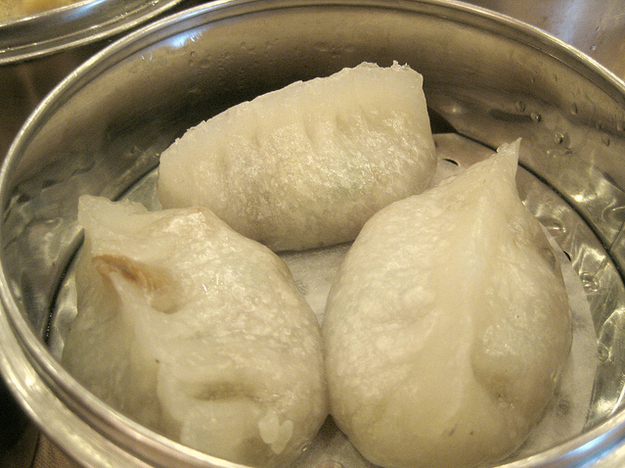

(Mand. fenguo; Cant. fun gor)
MISCELLANEOUS WRAPPER FAMILY
Flattish steamed half-moons, with unique wrappers that are a translucent mix of wheat starch and cornstarch often characterized by a lack of folds, the edges brought together in a flat seam instead. Fun gor are generally filled with light mixtures of ingredients like finely chopped pork, chives, peanuts, cilantro, salted turnip, and dried shrimp. Wrappers for fun gor and related dumplings are made from wheat starch rather than flour, so the practically gluten-free dough melts in the mouth. Fun gor may also be formed into shapes like stingrays or rabbits for special occasions and banquets. Typically steamed, they can also be steam-fried. Fun gor are believed to have become popular outside their homeland in Daliang around eighty years ago. Exterior slightly tacky and shiny; interior nongreasy and lightly crunchy.
“HAR GOW” 蝦餃
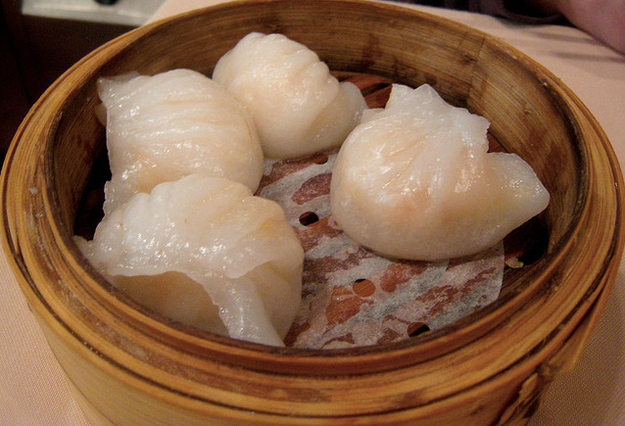

(Mand. xia jiao; Cant. har gow)
MISCELLANEOUS WRAPPER FAMILY
Thin, translucent wrappers of wheat starch and cornstarch containing firm, fresh shrimp, bright pink in color, as well as tiny bits of fatty pork and bamboo shoots for added textural contrast. Multiple delicate folds on one side only give this dim sum its singular shape. Har Gow were created at the beginning of the last century in Guangzhou, the capital of Guangdong Province, by the owner of a small, family-style teahouse on the river’s edge. Anxious to beat the competition, the teahouse owner took advantage of the fresh shrimp sold by fishermen directly from their boats. He adorned the local catch with little more than a bit of fresh bamboo shoots and pork, and enclosed it in delicate wrappers. Exterior slightly tacky and shiny; interior crunchy and nongreasy.
STICKY RICE WRAPPED IN LOTUS LEAVES 糯米雞
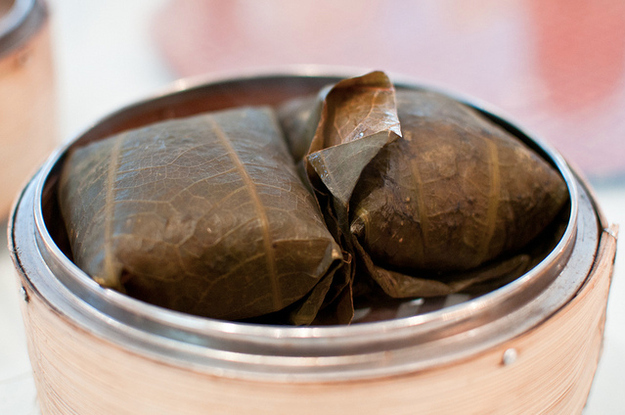

(Mand. nuo mi ji; Cant. lo mai gai)
MISCELLANEOUS WRAPPER FAMILY
Glutinous (sweet) rice mixed with a variety of savory ingredients before being wrapped in a soaked, dried lotus leaf and steamed until tender. The main meat ingredient is chicken (often from the thigh or leg) and Cantonese sausages are usually added, and barbecued pork, dried shrimp, dried scallops, dried mushrooms, and bamboo shoots are all fair game. The leaf is not tied, but rolled up and stacked with other packets in a steamer. A common variation is called pearl chicken, to make it, large pieces of raw poultry are coated in water-soaked raw rice and combined with other seasonings, folded up in a lotus leaf, and steamed until cooked through. Another variation is the a similar filling packed and steamed in bamboo leaves. Exterior a moist, inedible leaf; interior tender rice mixed with plump chicken pieces, chewy sausage, and other small, salty morsels.
STUFFED BEAN CURD 酿豆腐
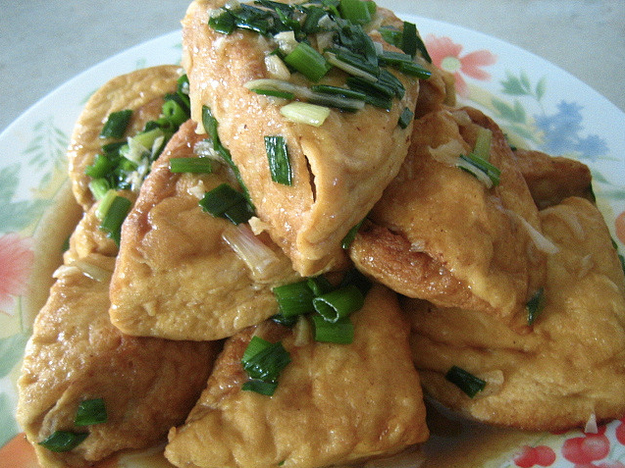

(Mand. niang doufu; Cant. yong tau foo)
UNWRAPPED PROTEIN
Bean curd (tofu) that is hollowed out and stuffed, and either cut in squares or in triangles. The filling is usually pork, but may be shrimp or fish paste, and sometimes mixed with chopped water chestnut, ginger, and other crunchy bits. The bean curd is then either lightly pan-fried or deep-fried before being slowly cooked in a savory soy-and-ginger-based sauce. (It may also be simply steamed or poached.) Eggplant, lotus root, bitter melon, chili peppers, and sweet peppers may be used in lieu of bean curd. This is a Hakka-style dish. As the Hakka people—originally migrants from the north—became assimilated into the local Cantonese culture, some of their foods—including yong tau foo—found their way into dim sum teahouses. Exterior soft, firm, or deep-fried, which gives it a chewy skin and meaty texture; filling is always juicy, and in strong contrast to the exterior.
CHICKEN FEET IN FERMENTED BLACK BEAN SAUCE 豉汁鳳爪
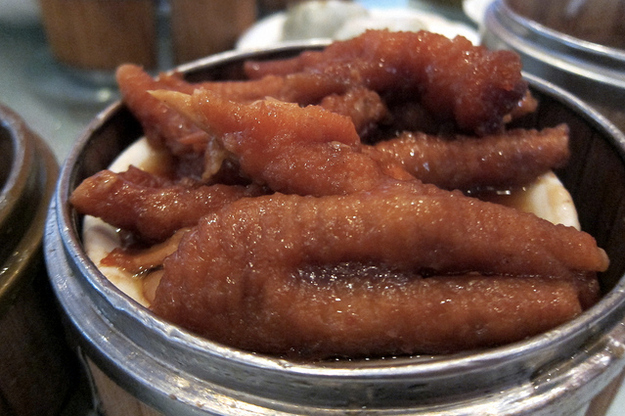

(Mand. chizhi feng zhao; Cant. tau zi fung zao)
UNWRAPPED PROTEIN
Whole chicken feet with the nails removed that have been deep-fried and then braised in a rich, slightly sweet sauce until tender. They are then placed on small plates and steamed with fermented black beans and other aromatics; fresh chilies may be added just before serving. There is zero meat to be had here. Rather, the tough bird skin becomes tender, soft, and gelatinous as it absorbs the braising liquid, which is rich with garlic and fermented black beans and chilies. Beneath the skin is a layer of slightly sticky tendon, which feels very much like a gummy bear left out in the sun. Holding everything together is a network of bones that are not much larger than watermelon seeds in the toes, but long and smooth in the ankles. The numerous tiny bones need to be removed as the feet are eaten, so this dish is usually consumed in small bites with a spoon close to the mouth to convey discarded bones. Referred to as “phoenix claws.” Exterior soft and supple; interior lightly chewy (tendons) with a bone.
STEAMED SPARERIBS WITH FERMENTED BLACK BEANS 豉汁排骨
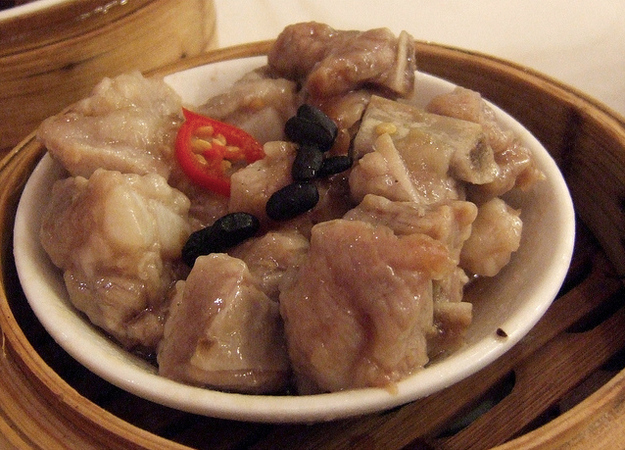

(Mand. chi zhi pai gu; Cant. zi jup paai gwat)
UNWRAPPED PROTEIN
Pork spareribs crosscut into one-inch pieces and then cut again midway between each bone so that every portion is more or less a one-inch cube. Steamed with fermented black beans, ginger, and other aromatics until tender. May have chilies present. Entire piece of meat is extremely juicy and flavorful, with thin tendons around the bone and chunks in the sauce. Variations include different types of sauces, such as ones with sour plums. Almost every non-Muslim region of China has its own take on these small spareribs, which can be deep-fried, steamed, braised, or cooked in stock. Cut this way, the spareribs are easy to pluck up with chopsticks and nibble over a spoon, with special attention paid—as always—to the chewy tendons and sticky sauces that cling to the crannies. Exterior firm yet tender with a rich, salty sauce; center usually contains a bone.

POTSTICKERS 鍋貼
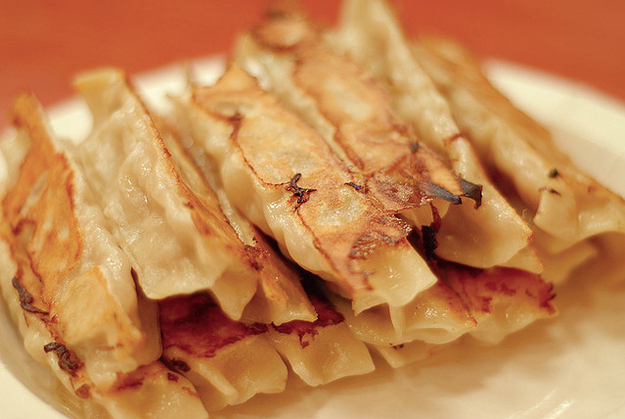

(Mand. guo tie; Cant. wo tip)
PAN-FRIED WRAPPED DUMPLINGS
Thin rounds of wheat pasta, usually with a ground-meat filling, crimped along the top and then steam-fried. The Chinese and English names come from the crust that forms on the bottom of the dumplings as they brown and stick to the pan; they should be served so that the golden bottoms and their sometimes lacy edges are on top. The most traditional form of pot stickers, as made in the northern port of Tianjin (near Beijing), have a long, even shape and both ends slightly open, which distinguishes them from being simply fried steamed dumplings (zheng jiao). Most common throughout North China, but have spread throughout the rest of the country. Alt. spelling: gyoza (Japanese). Exterior dry on top, crisp on the bottom; interior juicy and savory.
RADISH CAKES 蘿蔔糕
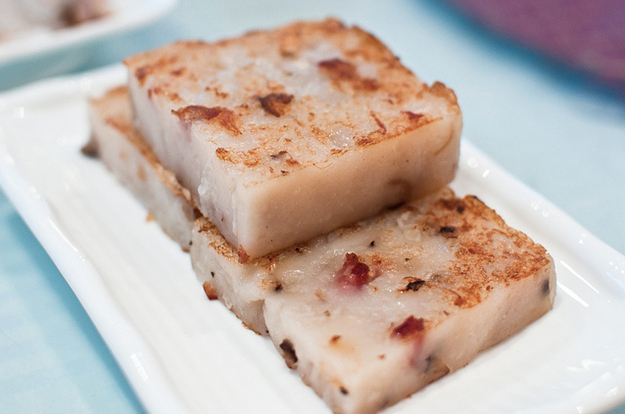

(Mand. luobogao; Cant. lo bak gou)
PAN-FRIED UNWRAPPED CAKE
Large, mild Chinese radishes grated and mixed with a rice-flour batter, and steamed in a large mold until cooked through. The cake is then cooled and cut into half-inch slices and pan-fried until crispy. Savory ingredients such as finely chopped Cantonese sausages, black mushrooms, dried shrimp, and fried shallots are added to the batter. Often accompanied by a reddish vinegar sauce; may also be simply steamed, cooled, sliced, and served with soy sauce. Radish cakes are commonly served at Chinese New Year celebrations in the Chaozhou area of Guangdong, where the dialect name for the Chinese radish (“chai tow”) is a homonym for wealth, making Radish Cakes are harbinger of good fortune for the coming year. Variations can be found in other areas of southern China, such as southern Fujian and Taiwan. The most common variation is taro cake, made with mature taro in lieu of the grated radish. Crispy exterior; creamy interior often studded with chewy bits.
RADISH PUFFS 蘿蔔酥
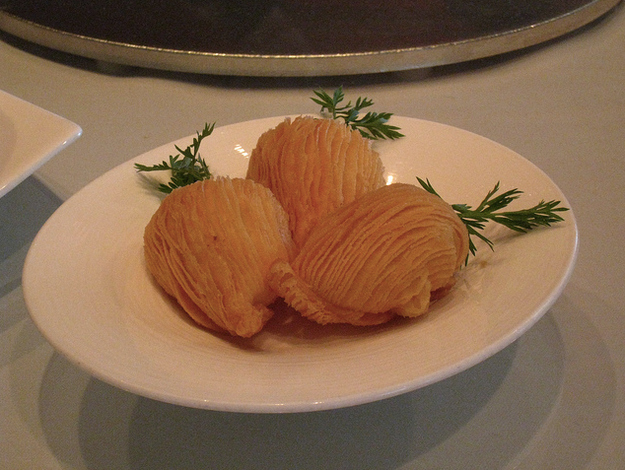

(Mand. luo bo su; Cant. lo baak sou)
WRAPPED & BAKED PASTRY
Cantonese-style puff pastry wrapped in a spiral pattern around a shredded radish filling. The Chinese radish is shredded into very thin strips and mixed with finely minced Chinese ham, green onions, and ground black pepper. This mixture is stir-fried before it is rolled into the puff pastry, which is then baked or deep-fried until golden. The most famous variation is Shanghai’s Radish Thread Flaky Pastries (luobosi subing). Chinese pastry crusts, which use rendered lard rather than butter, have little distinctive flavor of their own and instead serve as backdrops for their fillings. In the south, many layers of short pastry are folded between sheets of plain dough that are cut into separate pieces. The pastry expands into numerous crispy layers as it bakes. Northern-style pastries are similar to those of the south, but small marbles of short dough are traditionally wrapped in equally small sheets of plain dough to form puff pastry for the individual sweet or savory items, and so the layers are not as evident until the pastry surface is broken. Exterior crunchy and dry; interior filled with savory, seasoned, barely done radish in long strings.
CURRY TURNOVERS 咖喱角; 咖哩角


(Mand. kali jiao; Cant. gaa lei gok)
SAVORY: WRAPPED & BAKED
A Chinese egg-dough or puff-pastry dough, cut into 2-inch circles, with a finely minced curry filling, mainly of beef and onion, placed in the center; the edges are folded over to form a half-moon and sometimes crimped. An egg-yolk wash is usually applied to the surface of the egg dough only before the turnover is baked, though the turnovers may also be deep-fried without the egg wash. Sometimes spring-roll wrappers are used and folded into layered triangles; these are always deep-fried. In all cases, the turnover puffs up and becomes flaky and golden. Exterior light and flaky; interior soft and lightly spicy.
FRIED RICE-DOUGH PACKETS 鹹水角


(Mand. xian shui jiao; Cant. hom sui gok)
DEEP-FRIED WRAPPED PROTEIN
A lightly sweetened rice dough mixed with a little wheat starch, lard, and boiling water, formed into small wrappers, and then filled with a loose mixture of meats, dried shrimp, and vegetables (such as salted turnips, bamboo shoots, black mushrooms, and water chestnuts) bound together in a light gravy. Formed into slightly elongated ovals with gentle points at each end, the packets are fried to a golden brown, which puffs them up. This creates many textures, as the surface becomes almost like sandpaper, and yields to a sweet and slightly tacky dough balloon that holds the tiny offering of savory, chewy seasonings inside. Global fame has come to rice dough through Japanese mochi, but it’s also a staple in the ethnic minority areas of Yunnan and Guangxi, where it is the basis for a sticky sweet called ziba and other treats. It is most often used unsweetened in place of other starches, as in Hakka-style tamales. In the north, rice dough is an important part of the winter and spring holidays, since the winter solstice is celebrated with little rice-dough balls in a sweet soup (these appear again during Chinese New Year to symbolize togetherness). Exterior dry and sandy; interior savory and moist.
WRAPPED CRAB CLAWS 酿蟹鉗
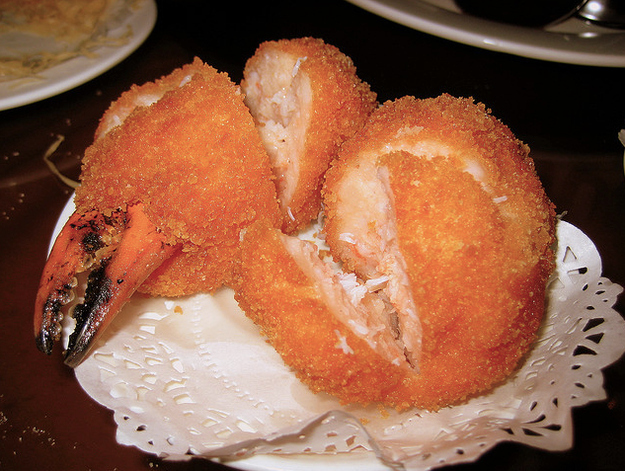

(Mand. niang xie qian; Cant. yeung hai kim)
DEEP-FRIED WRAPPED PROTEIN
The shell of a crab claw is removed, leaving only the part covering the pincers as a handle. Then a forcemeat of shrimp—either mixed with pork or crab or shrimp alone—covers the meaty part of the claw, forming a ball. This forcemeat may be seasoned with ginger, green onion, and rice wine. This forcemeat is rolled in a double-bound coating (cornstarch, egg wash, then bread crumbs) before it is deep-fried; may also be steamed without the breading. The Cantonese approach to shrimp forcemeat is to present the shellfish in all its glory, with only a bit of fat to amp up the mouthfeel, plus seasonings to perfume the whole. The goal is to create forcemeat that “bounces” back on the teeth. The shrimp is chopped by hand so as to achieve good variation between coarse and fine, and is carefully chilled to make the shrimp as firm as possible. Variations on this theme include wrapping the shrimp mixture around blanched asparagus tips or stuffing black mushroom caps; both of these are steamed rather than fried. Alt. name: stuffed crab claw (direct translation of the Chinese name). Exterior crunchy and dry; interior initially soft and juicy, and then just the sweet flavor and firm texture of crabmeat.
TARO-WRAPPED PORK 芋角
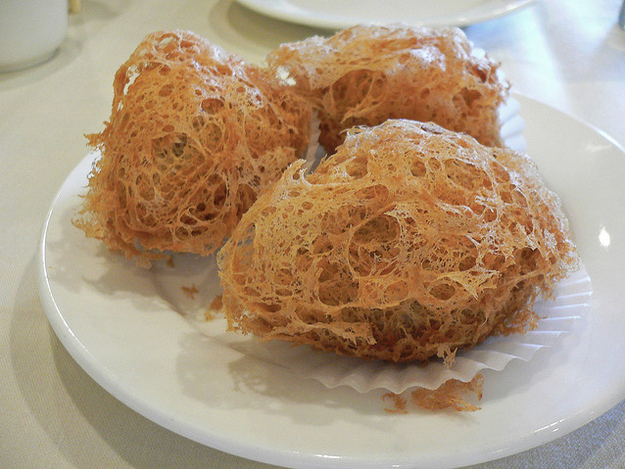

(Mand. yu jiao; Cant. wu gok)
DEEP-FRIED WRAPPED PROTEIN
Large, starchy taro root is cooked and mashed like a potato, and then mixed with wheat starch, lard, and boiling water to form a thick paste. Ground pork is the main ingredient for the filling, although fresh shrimp, barbecued pork, black mushrooms, bamboo shoots, and green onions may be added to form a rough mixture in a light gravy. The cooled taro paste is formed into a firm dough that is then cut into individual pieces that are filled with the meat mixture. These are rolled by hand into a loose football shape. When deep-fried, the taro puffs up into what the Chinese call feng chao or a “honeycomb.” This is a netting-like crust formed by the explosion of the taro coating in the hot oil, which gradually yields to a softer taro layer. Taro is a tropical starch, so it makes sense that it’s mainly used in the cuisines of southern China. There are two basic kinds of taro: the large, football-sized roots, and the small immature ones that are little larger than golf balls. The big ones are starchy and dry, and will often cook up to a striking lavender hue in such desserts as Chaozhou’s Taro Pudding; the taro flavor is much more pronounced in the larger sizes. The smaller ones are juicier and more fibrous, remain a pale gray when cooked, and tend to be steamed, peeled, and added to braises, where they can range in texture from as soft as a potato to as vegetal as a cooked bamboo shoot; their flavor is generally mild and somewhat like a cross between a bamboo shoot and a potato. Exterior webbed and brittle, then soft and pasty; interior meaty and gravelly.
ROAST DUCK 烤鴨; 燒鴨
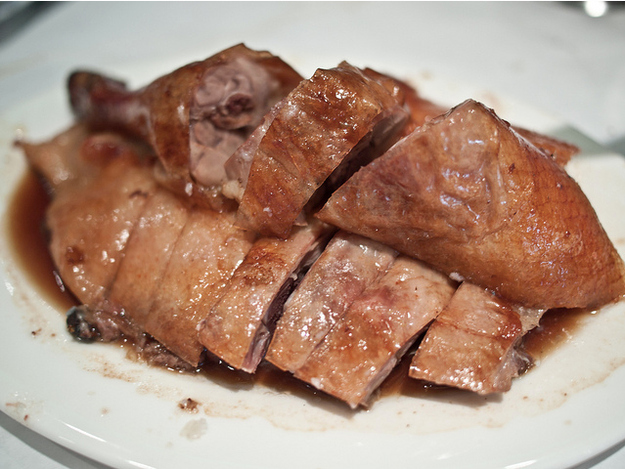

(Mand. kao ya; Cant. siu aap)
ROASTED MEAT
Cantonese-style roast duck is usually served in portions of a half or quarter bird. No matter which style of roast duck is served (and there are a number of different recipes), the brown skin is usually fairly crisp, with the fat layer distinctly separate from both the skin and the slightly pink meat. The duck will generally have a sauce that varies from lightly to very sweet, and the meat itself will be savory and juicy. The meat is cut into roughly half-inch slices in the kitchen prior to serving, but the bones remain in the duck, and the pieces will be reassembled to look like a complete section. Sometimes served over a scattering of sweet and savory cooked soybeans, most often with a small bowl of plum sauce on the side. Restaurants will generally offer only one kind of duck that is seasoned with salt, pepper, rice wine, and either Worcestershire sauce or soy sauce. Exterior crispy and sweet; interior initially fatty and then lean and juicy.
SUCKLING PIG 片皮烤乳豬
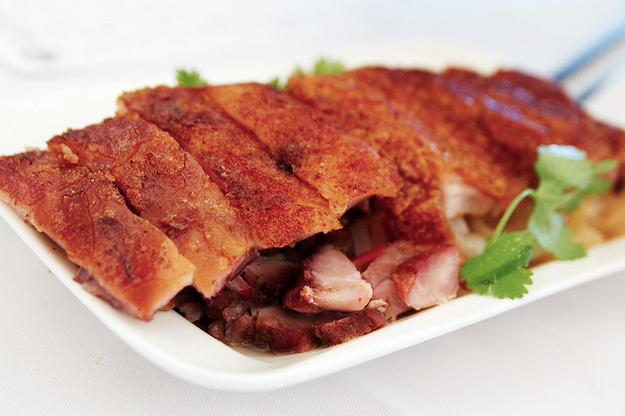

(Mand. pian pi kao ru zhu; Cant. pin pei siu jyu jyut)
ROASTED MEAT
A whole suckling pig is prepared as follows: the skin is lacquered with repeated layers of maltose and Zhejiang vinegar, while the meat is marinated with hoisin sauce, sesame sauce, and other seasonings. The result is an extremely tender meat with an almost gelatinous texture. The roasting process lifts the skin off the meat so that it becomes brittle, and the fat and meat layers become distinct. The skin may be eaten separately from the meat with steamed buns and hoisin sauce if these accoutrements are provided (usually at fancier banquet dinners). But this is not the custom at dim sum teahouses, where the suckling pig is sometimes served without any adornment. Exterior brittle; interior initially fatty and then leaner and juicy; bones soft and very much like cartilage.

MANGO PUDDING 芒果布丁; 芒果布甸


(Mand. mangguo puding; Cant. mong guo bo din)
COOL SWEETS: PUDDINGS
A soft, tropical pudding—containing the pulp of ripe mangoes blended with milk, sugar, gelatin, sugar, and sometimes eggs—that is chilled and served cold in individual cups; often molded into decorative shapes. Usually a pale orange in color, with small pieces of mango sometimes folded into the pudding or added as a garnish; some chefs drizzle condensed milk over the pudding. Additional garnishes may also include berries, mint, parsley, whipped cream, and similar items of contrasting color and/or texture. Probably derived from the traditional British favorite blancmange, which is sweetened and thickened milk or cream that is most often flavored with almonds, molded, and served cold. Various sizes. Variations include coconut and tapioca with chunks of taro or canned fruit. Exterior and interior uniformly soft and creamy, often with bits of mango in the dessert.
CUSTARD TARTS 蛋塔; 蛋撻
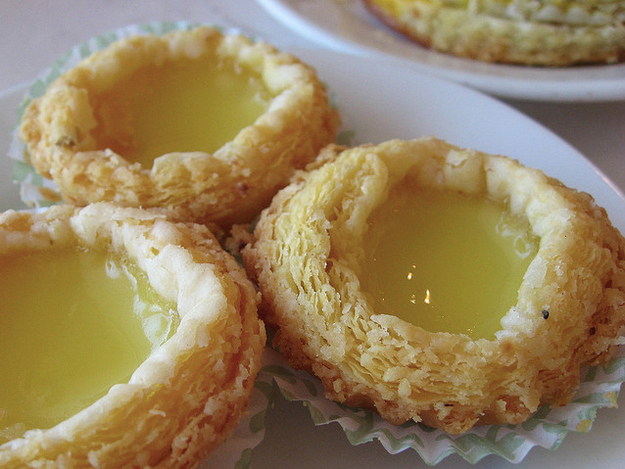

(Mand. dan ta; Cant. daan taat)
COOL SWEETS: TARTS
Chinese puff or short pastry in individual tartlets hold a light, sweet custard that is baked until barely solid. The pastry is akin or identical to that of curry turnovers, cut into small circles, and fitted into round tartlet pans, then blind-baked and filled with a sweet, rich custard mixture—basically egg, milk of some sort, and vanilla—and cooked again until the custard is tender. These tarts can be enjoyed warm or cool. Custard tarts are, in all likelihood, a Guangzhou interpretation of the English custard pie made sweeter and in small tartlets rather than as a single, open-faced pie. The Portuguese custard tart (pasteis de nata), has a browned top, and is another recent variation. Exterior crisp and flaky; interior soft and eggy.
FRIED SESAME BALLS 煎堆


(Mand. jian dui; Cant. jian dui)
HOT FRIED SWEET
Airy balls of sweetened, glutinous rice dough, the outside covered with white sesame seeds before being deep-fried. This popular Chinese New Year treat is now an everyday dim sum offering, and while fillings may vary, sweetened red bean is the most common. Hot, crisp, and round right out of the fryer, they quickly deflate and soften as they cool. The Cantonese name, jian dui, literally means “fried lumps.” In the north, fried sesame balls are referred to as ma tuan (sesame orbs), rather than jian dui. Because they are not confined to one single area—and appear in various guises throughout China—they have local names to match, such as ma yuan (sesame balls) in cold Manchuria near Russia and zhen dai (jeweled bags) all the way down in the tropical island province of Hainan in the South China Sea. Though the balls are usually two inches, some restaurants and street hawkers make them larger: six or more inches in diameter. Exterior slightly crispy and covered with toasted sesame seeds, yields to a tender layer of sweet rice dough; interior a marble of sweet red-bean paste.
SWEET CUSTARD BUNS 奶皇包
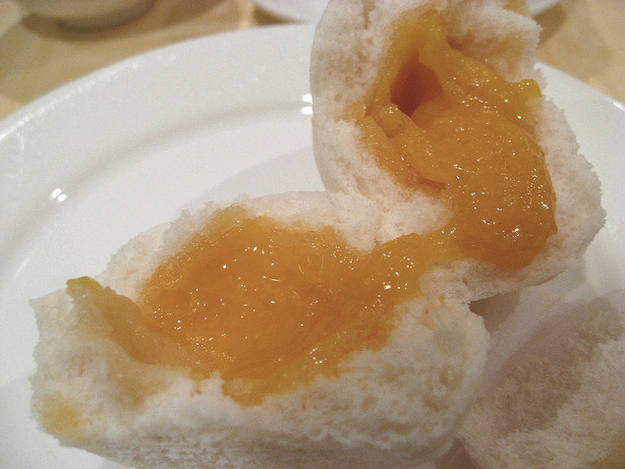

(Mand. nai huang bao; Cant. lai wong bao)
HOT STEAMED SWEET
Regular Chinese bread dough that has been slightly sweetened and formed into smooth, round buns with the seams hidden on the bottom. The filling is a bright yellow custard usually made with eggs, sugar, butter, cornstarch, milk, condensed milk, and custard powder. When cooled, the filling is formed into balls, tucked into the raw bread dough, and typically steamed (though they may also be baked). If the bun is served hot, the filling will often be runny, like the yolk of a soft-boiled egg. Usually has a waxed-paper square on the bottom. Exterior shiny white and slightly sweet springy bread; interior a bright yellow custard that is sometimes soft and semiliquid when warm and then solid when cool.
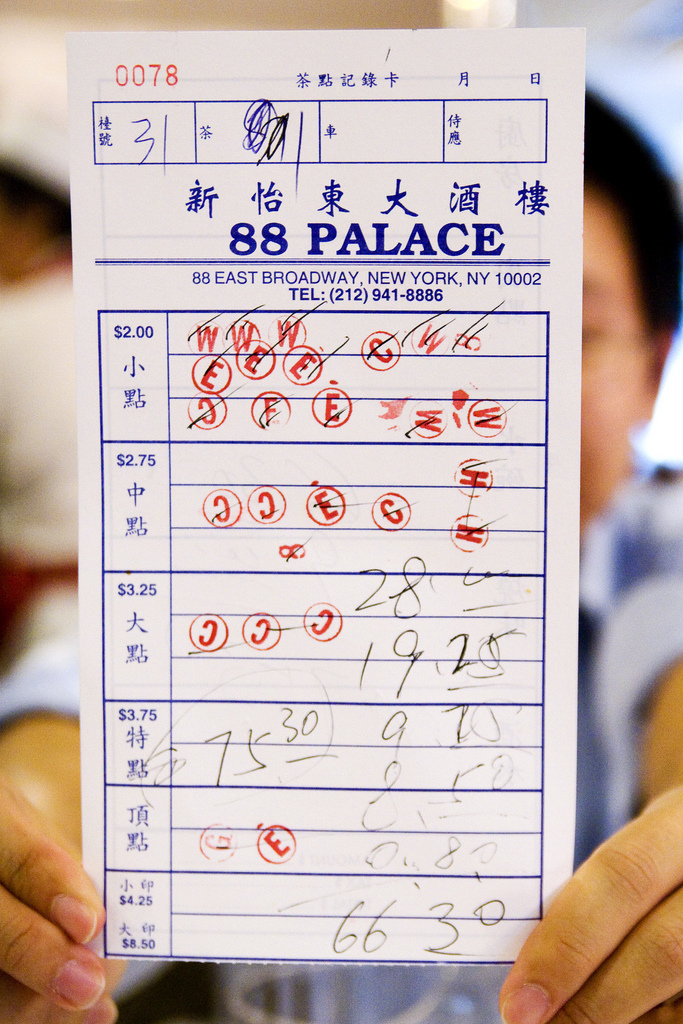
This excerpt has been reprinted with permission from the Chinatown issue of Lucky Peach, a quarterly food journal published by McSweeney's. It's available for purchase here. Subscriptions are available here. You can also follow Lucky Peach on Twitter. The photography was sourced from dim sum fans on Flickr. Carolyn Phillips's upcoming book on Chinese cuisine will be published by McSweeney's in 2014.
